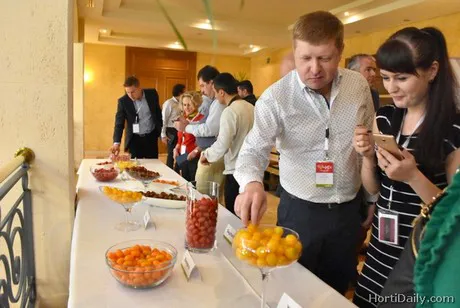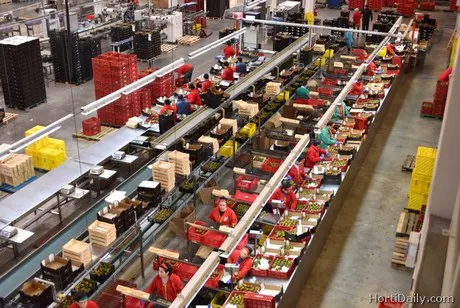
Since the last Syngenta snack tomato event four years ago, the snack tomato market has developed. “We’ve seen a tremendous growth to the segment and hope our partners in the tomato business saw this as well. But now, a big shift is occurring: there are more challenges for producers, marketers and retailers. Investments are getting higher”, Syngenta’s Matthew Johnston kicked off the conference. Syngenta has been leading in this segment for years and with their current catalogue and several new varieties coming up, this position is solid. Preparing for the future by connecting with the partners in the chain therefore also is an important topic to the breeding company.
Why the end customer is so important
“What I see most in supermarkets are commodity goods. Also, tomatoes are basic products. The problem with this is that you focus on price – which is not good for you, nor for the shopper.” According to Edwin Paul Vels, retail consultant and partner of FMCG education, lessons can be learned from other products. “Focus on the shopper! Check out the last shopper and consumer trends and guide them through it. Look at oil, look at yoghurt – they’ve created special products for every moment of the day.” Paul sees opportunities here for tomatoes as well. He points out that the more tomatoes there are on the shelves, the more stressed a shopper gets. “He doesn’t know what to use tomatoes for anymore. Quit the overload and start the separation into segments: are they for soup, for salads? Guide the buyer with the moment of use.”

Also the preparation for the online shopper, an important theme according to the numbers Pierre Escodo of Eurofresh magazine showed during the day, are something to prepare for. Starting a recognizable brand is key in this, sees Paul.
Michiel Meekels, independent fresh consultant, confirmed this. He brought the world of the millennials towards the industry. Owing less, sharing more, willing to pay for experiences and convenience – as long as the experience and the brand suits their needs. “A brand needs to mirror their specific business tone of voice and mission next to their customers’ needs and values.”
What does your consumer think of your product?
Growers might have this in focus already and the conference speakers once again confirmed it: closing the chain and focusing not only on your direct trade partners, but on the other segments in the chain, are key to remain on top of the market. Jelger de Vriend, retail expert at Fresh Strategies and co-founder of Innovative Fresh, spoke about this connection with the final customer. “These days, every supermarket has the ambition to be the best in fresh. This is something of the last couple of years and it’s a great opportunity for the fresh world. And the tomato category is the center of the fresh universe”, he stated.
So how to increase the tomato consumption? According to Jelger, the formula is quite easy. “Combine appearance and visibility and a consumer will be tempted to do a trial. To have a consumer repeat the buy, the product has to be available year-round, consistent in quality and full of flavour. Flavour is the factor to activate re-purchasing – the key to a higher production.” Well wait – how about price in all this? “Re-purchasing is not about price. It doesn’t matter to a consumer if he pays 1.79 or 1.89 for a good product – but let them pay 19 cents for a cucumber and the quality is bad, nobody will return.”

Throughout the value chain
At Wageningen UR, innovations are created as well to make sure the end consumer is set up with the best fitting quality possible. “Post-harvest is not only about technology, but also about the product itself. How is it behaving and can we adapt the environment in a way that the product will remain fresh?”, Eelke Westra explained. “Consumers get more critical. With e-commerce, we’re moving towards a personalised value chain.” By creating a system to measure the quality exactly – including the taste – predictions can be made to get the right product at the right consumer.
A complex Bayesian Network can play a role in this. “Models like this are important because humans tend to fail to change their mind in the face of changing evidence. When big data takes a hit, it will bring more opportunities to combine all the data in the value chain and solve one question with it: What is the expected quality attribute of the tomato cultivar produced by a certain grower in a certain season in store for a number of days with a certain packaging?”

Why these developments are important to a breeder
During the day it became clear that closing the chain and getting to know your customer is the topic in the snack tomato industry for the next years. With technologies like gene editing no longer on the horizon but becoming reality, there are massive opportunities in this for the breeder. “Learning from all these new habits and trends we are working on new segmentation and traits. Let’s talk about flavour for example: the majority of people think of brix and sugar, but how about texture? This will change the experience of taste.” Also trends like sustainability and the rising popularity of organic and residue-free produce are in focus. “We try to deliver more resistances and traits to make crop protection easier and maximize the yield.”
But cooperation in the market is necessary as well when looking for subjects like the illegal propagation of protected varieties. “When there’s more product on the market than what was planned and people are producing at lower costs, this can be a huge risk. By creating a platform that can help us protect what we develop and at the same time protecting your business, we are working on this.”
Haven’t had enough of the snack tomatoes? We’ll keep you posted the coming days with more snack stories! For now, check out the photo report!
